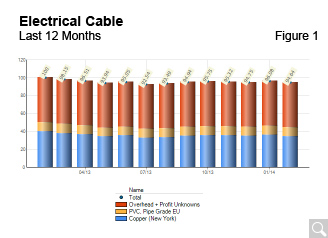Know What You Should be Paying
In a Perfect World
Imagine the negotiating edge you would have if you knew – and could demonstrate – what you should be paying for the products you buy, especially when suppliers approach you for price increases, saying they just can’t hold off any longer because of rising costs at their end.
This is not wishful thinking.
This kind of negotiating advantage is available if you create a simple model that estimates what the effect of changing raw material costs should have on your suppliers’ selling prices. Believe it or not the process can take less than 15 minutes.
A Simple Model is All You Need
Modeling selling prices (i.e., the prices you pay) starts with an educated guess. Let’s use electrical cable as an example. The main commodities are copper and PVC (a typical insulation material). Let’s say your current price is $1 per foot. We estimate the copper is worth about 40 cents or 40% of the selling price (we could weigh it or just guess). We do the same with the PVC insulation and estimate it represents 10% of the selling price. The remaining 50% we allocate to the supplier’s profit, overhead and anything we’ve left out.

Let’s say it been a year since you last negotiated cable pricing; figure 1 on the right shows what your graph should look like. Note it shows a 5.36% decrease, mainly due to falling copper.
With this information, you now know, before going into negotiations, that a decrease is in order. You have two choices. Either take the initiative and show this to your supplier. This approach lets you set the tone of the negotiations; he will clearly understand your expectations. Or you can test his mettle by waiting for him to make an offer, and then taking appropriate action. Both strategies have their pros and cons; it’s your call.
This model can be easily created in Excel by inputting monthly copper and PVC cost (which are available from many Internet sites) and keeping the other costs constant (i.e., supplier’s overheads, profits and unknowns). Moreover, you can quickly modify it as you interact with your supplier and learn more about his costs.
Modeling Almost Anything Works to Your Advantage
Simple models are easy to build: the trick is to only include the really important raw materials. The purpose of modeling is not to impress the supplier with your knowledge, but rather to create negotiating momentum in the direction you choose.
Asking for his input (e.g. correcting your model) is usually a good move. His participation means he ‘owns’ the model too and, therefore, can’t easily dispute the results. Agreeing on price becomes much less of a contest, saving valuable time for both of you.
There are two other important benefits of modeling:
- you create a robust, cost effective supply-chain;
- and you solve the frustrating problem of chronic ‘price creep’.
Substantial rewards, I’m sure you will agree, for the time and effort needed to develop this new skill.
Questions?
We are here to help.
Copyright ProPurchaser.com 2024
